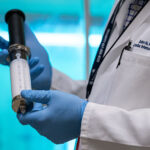Microbiome therapeutics: 6 takeaways from a MassBio panel

Seeing the surprising success of “poop pills” in gastrointestinal C. difficile infection, pharma companies and startups are embracing the microbiome as a new therapeutic target for an astonishing range of maladies. To learn what pioneering companies in the space are thinking about the hope and the hype, Vector recently attended a panel on microbiome therapeutics at the MassBio Annual Meeting. The panelists were:
- Jose-Carlos Gutierrez-Ramos, CEO, Synlogic
- Alan Moss, Associate Professor, Medicine, Harvard Medical School
- Bernat Olle, Co-founder and CEO, Vedanta Biosciences
- Kareem Reda, VP of Business Development, Evelo Biosciences
These highlights from the discussion show industry’s excitement about the new therapies aimed at rebalancing a patient’s microbiome — medicines targeting or protecting our resident microbes, as well as actual microbe formulations — and the hurdles to be overcome:
1. The microbiome is easy to understand.
Moss and Olle pointed out that treating the microbiome is a story patients are interested in, can readily understand and can imagine for themselves. “My mom would not get CRISPR,” said Olle. As the panelists noted, many consumers have been using microbiome products available through the OTC market.
2. Probiotics are accepted as safe.
When Olle came back from a visit to Mexico with a stomach illness, his doctor recommended that he take a probiotic — any product. Widespread clinician acceptance of probiotics “puts a company in an enviable starting place because microorganisms are known to be safe,” Olle said. “We live with them in our gut in millions.” Still, he warned, companies developing prescription products will need to prove safety to the FDA. Gutierrez-Ramos added while many new studies show that our microbiomes are key in preventing, causing or treating diseases, in many cases we don’t know what the microbes do. His company, Synlogic, hopes to bring pharmacological precision to the probiotic field.
3. The FDA regulatory path for microbiome therapeutics is uncertain.
What defines microbial colonization? What does colonization do? How fast is colonization? What do pharmacokinetics/pharmacodynamics or automatic scaling mean in a microbiome context? “There are a lot of questions to answer before a new therapy can be FDA-approved,” said Gutierrez-Ramos. “We are going to write these rules as we move forward.”
Reda’s company, Evelo Biosciences, is staying away from the unregulated probiotic/nutraceutical field (which he likened to “the snake oil salesman of the Wild West”). The company plans to go through the FDA for safety and efficacy reviews, justifying a higher price for the therapy.
Does the FDA have the expertise to properly review microbiome candidates? Gutierrez-Ramos believes that now is an ideal time to go to the FDA with a new therapeutic platform. In addition to small molecules, the FDA now has expertise in varied biologics, including gene therapy and cancer vaccines. Microbiome-altering modalities give a company the opportunity to work with the FDA and shape regulations for future therapeutics, added Olle.
4. Pharmacological precision must be applied to the probiotic field.
Gutierrez-Ramos warned that failing to think about the fine details can slow the field down — as happened for 10 years with gene therapy. He recommends caution, as the next two to three years will be fundamental for the probiotic field.
Therapeutic development will need both traditional pharmaceutical precision and new methods for studying and manufacturing these atypical therapeutics. “Every development step is a challenge because we are using tools pharma does not use,” said Olle. His company, Vedanta Biosciences, is developing ecological principles for how microbial strains interact with each other. Other questions include how durable the effects are and how microbial colonization in animal models predicts colonization in humans.
Olle believes it will take years of optimization and know-how to build a reproducible microbiome therapeutic. Gutierrez-Ramos agreed: His company plans to develop genetically engineered bacteria with function measured in vitro and in vivo. Engineering extremely potent bacteria will take a lot of careful experimentation.
Even within a microbe species, strains matter, noted Reda. In reports in the literature, a strain manufactured by Sanofi worked better than one from Merck for treatment of tuberculosis.
5. Target diseases for microbiome treatment will expand with time.
According to Olle, the bar for a successful microbiome therapeutic is lowest for infectious disease indications like C. diff. The next challenge will be altering the microbiome to change a person’s chronic immune response. Even more difficult are conditions that disrupt the metabolic system — where a patient’s diet may factor into the therapy. More speculatively, Olle believes that behavioral disorders and central nervous system conditions like Alzheimer’s and Parkinson’s may someday be treated through microbiome manipulation.
Reda, in contrast, believes cancer will be the next target disease. His company is studying bacteria–host interaction as it relates to cancer cells, and he believes there are microbes at tumor sites. The increased interest in the microbiome and cancer parallels the rise of immune-oncology 20 years ago, he said.
6. Consumers should choose wisely.
There are many organisms to explore to find ones that work therapeutically. For consumers wanting to try probiotics on their own, the panelists note that Lactococcus lactis and Bifidobacterium lactis, the most commonly found strains on the shelf today, are mostly ineffective. “They are not what the human gut looks like,” said Olle. He went on to say that microbes used in foods like yogurt are not selected with therapeutic goals in mind.
Boston Children’s has an array of researchers studying the microbiome and its role in diseases such as autism and inflammatory bowel disease. For information about microbiome research collaboration opportunities with the hospital, email tido@childrens.harvard.edu.
Related Posts :
-

A new tool could exponentially expand our understanding of bacteria
How do bacteria — harmless ones living in our bodies, or those that cause disease — organize their activities? A new study, ...
-

Could we cure or prevent food allergy by targeting an intestinal protein?
When is food simply nourishing and enjoyable, and when does it provoke an allergic reaction? The answer appears to lie ...
-

Could a pill treat sickle cell disease?
The new gene therapies for sickle cell disease — including the gene-editing treatment Casgevy, based on research at Boston Children’s ...
-

Injected microbubbles could be a safe way to deliver emergency oxygen
For years, researchers and clinicians have been trying to find a way to rapidly deliver oxygen to patients when traditional ...





